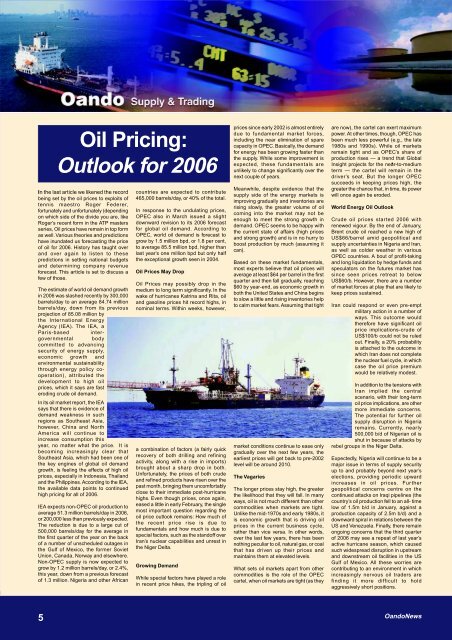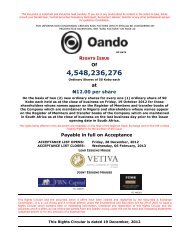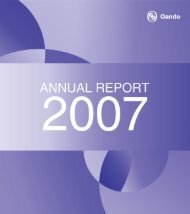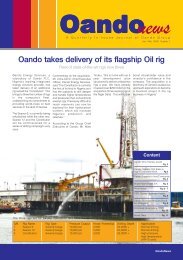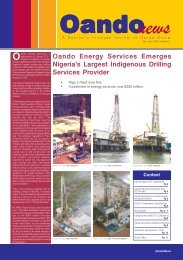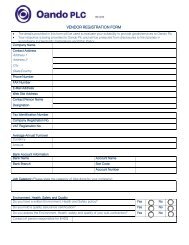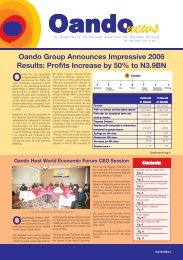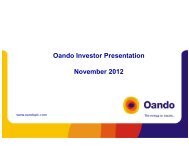Oando signs for OPL 278 with NNPC - Oando PLC
Oando signs for OPL 278 with NNPC - Oando PLC
Oando signs for OPL 278 with NNPC - Oando PLC
Create successful ePaper yourself
Turn your PDF publications into a flip-book with our unique Google optimized e-Paper software.
Oil Pricing:<br />
Outlook <strong>for</strong> 2006<br />
In the last article we likened the record<br />
being set by the oil prices to exploits of<br />
tennis maestro Roger Federer,<br />
<strong>for</strong>tunately and un<strong>for</strong>tunately (depending<br />
on which side of the divide you are, like<br />
Roger’s recent <strong>for</strong>m in the ATP masters<br />
series, Oil prices have remain in top <strong>for</strong>m<br />
as well. Various theories and predictions<br />
have inundated us <strong>for</strong>ecasting the price<br />
of oil <strong>for</strong> 2006. History has taught over<br />
and over again to listen to these<br />
predictions in setting national budgets<br />
and determining company revenue<br />
<strong>for</strong>ecast. This article is set to discuss a<br />
few of those.<br />
The estimate of world oil demand growth<br />
in 2006 was slashed recently by 300,000<br />
barrels/day to an average 84.74 million<br />
barrels/day, down from its previous<br />
projection of 85.08 million by<br />
the International Energy<br />
Agency (IEA). The IEA, a<br />
Paris-based intergovernmental<br />
body<br />
committed to advancing<br />
security of energy supply,<br />
economic growth and<br />
environmental sustainability<br />
through energy policy cooperation),<br />
attributed the<br />
development to high oil<br />
prices, which it says are fast<br />
eroding crude oil demand.<br />
In its oil market report, the IEA<br />
says that there is evidence of<br />
demand weakness in such<br />
regions as Southeast Asia,<br />
however, China and North<br />
America will continue to<br />
increase consumption this<br />
year, no matter what the price. It is<br />
becoming increasingly clear that<br />
Southeast Asia, which had been one of<br />
the key engines of global oil demand<br />
growth, is feeling the effects of high oil<br />
prices, especially in Indonesia, Thailand<br />
and the Philippines. According to the IEA,<br />
the available data points to continued<br />
high pricing <strong>for</strong> all of 2006.<br />
IEA expects non-OPEC oil production to<br />
average 51.3 million barrels/day in 2006,<br />
or 200,000 less than previously expected.<br />
The reduction is due to a large cut of<br />
500,000 barrels/day <strong>for</strong> the average in<br />
the first quarter of the year on the back<br />
of a number of unscheduled outages in<br />
the Gulf of Mexico, the <strong>for</strong>mer Soviet<br />
Union, Canada, Norway and elsewhere.<br />
Non-OPEC supply is now expected to<br />
grow by 1.2 million barrels/day, or 2.4%,<br />
this year, down from a previous <strong>for</strong>ecast<br />
of 1.3 million. Nigeria and other African<br />
countries are expected to contribute<br />
465,000 barrels/day, or 40% of the total.<br />
In response to the undulating prices,<br />
OPEC also in March issued a slight<br />
downward revision to its 2006 <strong>for</strong>ecast<br />
<strong>for</strong> global oil demand. According to<br />
OPEC, world oil demand is <strong>for</strong>ecast to<br />
grow by 1.5 million bpd, or 1.8 per cent,<br />
to average 85.5 million bpd, higher than<br />
last year’s one million bpd but only half<br />
the exceptional growth seen in 2004.<br />
Oil Prices May Drop<br />
Oil Prices may possibly drop in the<br />
medium to long term significantly. In the<br />
wake of hurricanes Katrina and Rita, oil<br />
and gasoline prices hit record highs, in<br />
nominal terms. Within weeks, however,<br />
a combination of factors (a fairly quick<br />
recovery of both drilling and refining<br />
activity, along <strong>with</strong> a rise in imports)<br />
brought about a sharp drop in both.<br />
Un<strong>for</strong>tunately, the prices of both crude<br />
and refined products have risen over the<br />
past month, bringing them uncom<strong>for</strong>tably<br />
close to their immediate post-hurricane<br />
highs. Even though prices, once again,<br />
eased a little in early February, the single<br />
most important question regarding the<br />
oil price outlook remains: How much of<br />
the recent price rise is due to<br />
fundamentals and how much is due to<br />
special factors, such as the standoff over<br />
Iran’s nuclear capabilities and unrest in<br />
the Niger Delta.<br />
Growing Demand<br />
While special factors have played a role<br />
in recent price hikes, the tripling of oil<br />
prices since early 2002 is almost entirely<br />
due to fundamental market <strong>for</strong>ces,<br />
including the near elimination of spare<br />
capacity in OPEC. Basically, the demand<br />
<strong>for</strong> energy has been growing faster than<br />
the supply. While some improvement is<br />
expected, these fundamentals are<br />
unlikely to change significantly over the<br />
next couple of years.<br />
Meanwhile, despite evidence that the<br />
supply side of the energy markets is<br />
improving gradually and inventories are<br />
rising slowly, the greater volume of oil<br />
coming into the market may not be<br />
enough to meet the strong growth in<br />
demand. OPEC seems to be happy <strong>with</strong><br />
the current state of affairs (high prices<br />
and strong growth) and is in no hurry to<br />
boost production by much (assuming it<br />
can).<br />
Based on these market fundamentals,<br />
most experts believe that oil prices will<br />
average at least $64 per barrel in the first<br />
quarter and then fall gradually, reaching<br />
$60 by year-end, as economic growth in<br />
both the United States and China begins<br />
to slow a little and rising inventories help<br />
to calm market fears. Assuming that tight<br />
market conditions continue to ease only<br />
gradually over the next few years, the<br />
earliest prices will get back to pre-2002<br />
level will be around 2010.<br />
The Vagaries<br />
The longer prices stay high, the greater<br />
the likelihood that they will fall. In many<br />
ways, oil is not much different than other<br />
commodities when markets are tight.<br />
Unlike the mid-1970s and early 1980s, it<br />
is economic growth that is driving oil<br />
prices in the current business cycle,<br />
rather than vice versa. In other words,<br />
over the last few years, there has been<br />
nothing peculiar to oil, natural gas, or coal<br />
that has driven up their prices and<br />
maintains them at elevated levels.<br />
What sets oil markets apart from other<br />
commodities is the role of the OPEC<br />
cartel, when oil markets are tight (as they<br />
are now), the cartel can exert maximum<br />
power. At other times, though, OPEC has<br />
been much less powerful (e.g., the late<br />
1980s and 1990s). While oil markets<br />
remain tight and as OPEC’s share of<br />
production rises — a trend that Global<br />
Insight projects <strong>for</strong> the near-to-medium<br />
term — the cartel will remain in the<br />
driver’s seat. But the longer OPEC<br />
succeeds in keeping prices high, the<br />
greater the chance that, in time, its power<br />
will once again be eroded.<br />
World Energy Oil Outlook<br />
Crude oil prices started 2006 <strong>with</strong><br />
renewed vigour. By the end of January,<br />
Brent crude oil reached a new high of<br />
US$66/barrel amid geopolitical and<br />
supply uncertainties in Nigeria and Iran,<br />
as well as colder weather in various<br />
OPEC countries. A bout of profit-taking<br />
and long liquidation by hedge funds and<br />
speculators on the futures market has<br />
since seen prices retreat to below<br />
US$60/b. However, there are a number<br />
of market <strong>for</strong>ces at play that are likely to<br />
keep prices sustained.<br />
Iran could respond or even pre-empt<br />
military action in a number of<br />
ways. This outcome would<br />
there<strong>for</strong>e have significant oil<br />
price implications-crude of<br />
US$100/b could not be ruled<br />
out. Finally, a 20% probability<br />
is attached to the outcome in<br />
which Iran does not complete<br />
the nuclear fuel cycle, in which<br />
case the oil price premium<br />
would be relatively modest.<br />
In addition to the tensions <strong>with</strong><br />
Iran implied the central<br />
scenario, <strong>with</strong> their long-term<br />
oil price implications, are other<br />
more immediate concerns.<br />
The potential <strong>for</strong> further oil<br />
supply disruption in Nigeria<br />
remains. Currently, nearly<br />
500,000 b/d of Nigerian oil is<br />
shut in because of attacks by<br />
rebel groups in the Niger Delta.<br />
Expectedly, Nigeria will continue to be a<br />
major issue in terms of supply security<br />
up to and probably beyond next year’s<br />
elections, providing periodic upward<br />
increases in oil prices. Further<br />
geopolitical concerns centre on the<br />
continued attacks on Iraqi pipelines (the<br />
country’s oil production fell to an all- time<br />
low of 1.5m b/d in January, against a<br />
production capacity of 2.5m b/d) and a<br />
downward spiral in relations between the<br />
US and Venezuela. Finally, there remain<br />
ongoing concerns that the third quarter<br />
of 2006 may see a repeat of last year’s<br />
active hurricane season, which caused<br />
such widespread disruption in upstream<br />
and downstream oil facilities in the US<br />
Gulf of Mexico. All these worries are<br />
contributing to an environment in which<br />
increasingly nervous oil traders are<br />
finding it more difficult to hold<br />
aggressively short positions.<br />
5 <strong>Oando</strong>News


